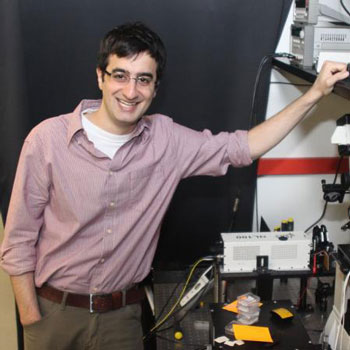| Oct 03, 2012 |
Multi-university research on quantum metamaterials funded
|
|
(Nanowerk News) Through a new Multidisciplinary University Research Initiative (MURI) awarded by the Air Force Office of Scientific Research, researchers from Brown University will lead an effort to study new optical materials and their interactions with light quantum scale. The initiative, titled Quantum Metaphotonics and Quantum Metamaterials, will receive $4.5 million over three years, with a possible two-year extension.
|
|
"The field of metamaterials has already expanded the range of optical materials and phenomenon available at larger, classical scales," said Rashid Zia, Manning assistant professor of engineering and the lead investigator of the initiative. "What we're doing now is asking what happens when we bring these metamaterials down to the scale of quantum emitters."
|
 |
| Rashid Zia
|
|
Harnessing the power of light at the quantum scale could clear the way for super-fast optical microprocessors, high-capacity optical memory, securely encrypted communication, and untold other technologies. But before any of these potential applications sees the light of day, there are substantial obstacles to overcome. Not the least of which is the fact that the wavelength of light is larger than quantum-scale objects, limiting the range of possible light-matter interactions.
|
|
"The optical wavelength is approximately 100 times larger than a quantum emitter," Zia said. "So we need to find ways of overcoming this size mismatch to increase interactions at the quantum scale, for example by shrinking the optical wavelength in highly confined metamaterial cavities. And hopefully we can learn something fundamental about the nature of light that opens up news ways of manipulating it to increase these interactions."
|
|
The Quantum Metaphotonics and Metamaterials MURI team includes:
|
|
Harry Atwater, California Institute of Technology
|
|
Seth Bank, University of Texas at Austin
|
|
Mark Brongersma, Stanford University
|
|
Nader Engheta, University of Pennsylvania
|
|
Shanhui Fan, Stanford University
|
|
Nicholas Fang, Massachusetts Institute of Technology
|
|
Arto Nurmikko, Brown University
|
|
Jelena Vuckovic, Stanford University
|
|
Xiang Zhang, University of California, Berkeley
|
|
Rashid Zia, Brown University
|
|
"It's really an exciting project," Zia said. "Over the next five years, this program will bring together 10 groups and 40-plus researchers with complementary expertise to help answer questions that we couldn't have imagined a short time ago. We are very optimistic about where this will lead."
|

